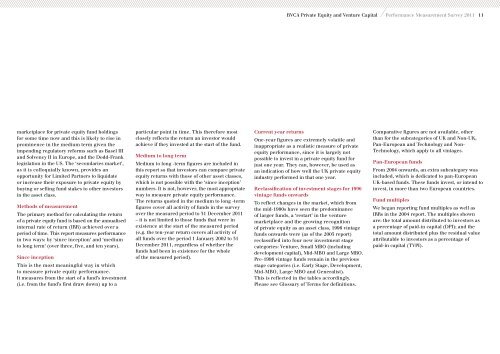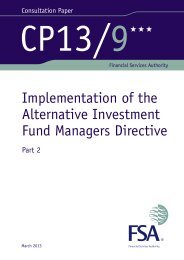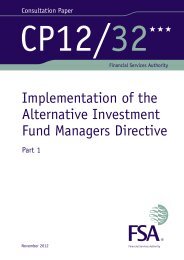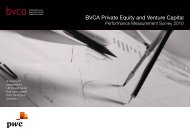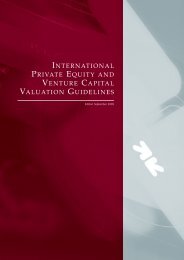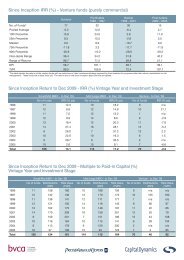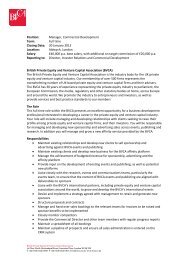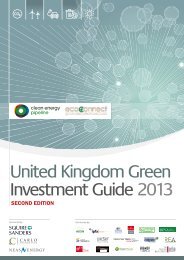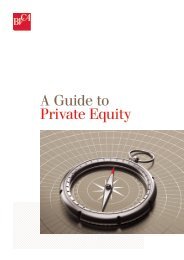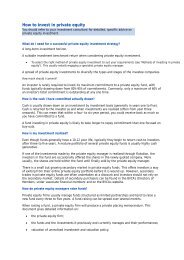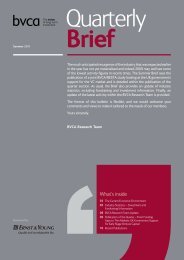BVCA Private Equity and Venture Capital ... - BVCA admin
BVCA Private Equity and Venture Capital ... - BVCA admin
BVCA Private Equity and Venture Capital ... - BVCA admin
Create successful ePaper yourself
Turn your PDF publications into a flip-book with our unique Google optimized e-Paper software.
marketplace for private equity fund holdings<br />
for some time now <strong>and</strong> this is likely to rise in<br />
prominence in the medium term given the<br />
impending regulatory reforms such as Basel III<br />
<strong>and</strong> Solvency II in Europe, <strong>and</strong> the Dodd-Frank<br />
legislation in the US. The ‘secondaries market’,<br />
as it is colloquially known, provides an<br />
opportunity for Limited Partners to liquidate<br />
or increase their exposure to private equity by<br />
buying or selling fund stakes to other investors<br />
in the asset class.<br />
Methods of measurement<br />
The primary method for calculating the return<br />
of a private equity fund is based on the annualised<br />
internal rate of return (IRR) achieved over a<br />
period of time. This report measures performance<br />
in two ways: by ‘since inception’ <strong>and</strong> ‘medium<br />
to long term’ (over three, five, <strong>and</strong> ten years).<br />
Since inception<br />
This is the most meaningful way in which<br />
to measure private equity performance.<br />
It measures from the start of a fund’s investment<br />
(i.e. from the fund’s first draw down) up to a<br />
particular point in time. This therefore most<br />
closely reflects the return an investor would<br />
achieve if they invested at the start of the fund.<br />
Medium to long term<br />
Medium to long -term figures are included in<br />
this report so that investors can compare private<br />
equity returns with those of other asset classes,<br />
which is not possible with the ‘since inception’<br />
numbers. It is not, however, the most appropriate<br />
way to measure private equity performance.<br />
The returns quoted in the medium to long -term<br />
figures cover all activity of funds in the survey<br />
over the measured period to 31 December 2011<br />
– it is not limited to those funds that were in<br />
existence at the start of the measured period<br />
(e.g. the ten-year return covers all activity of<br />
all funds over the period 1 January 2002 to 31<br />
December 2011, regardless of whether the<br />
funds had been in existence for the whole<br />
of the measured period).<br />
<strong>BVCA</strong> <strong>Private</strong> <strong>Equity</strong> <strong>and</strong> <strong>Venture</strong> <strong>Capital</strong> Performance Measurement Survey 2011 11<br />
Current year returns<br />
One-year figures are extremely volatile <strong>and</strong><br />
inappropriate as a realistic measure of private<br />
equity performance, since it is largely not<br />
possible to invest in a private equity fund for<br />
just one year. They can, however, be used as<br />
an indication of how well the UK private equity<br />
industry performed in that one year.<br />
Reclassification of investment stages for 1996<br />
vintage funds onwards<br />
To reflect changes in the market, which from<br />
the mid-1990s have seen the predominance<br />
of larger funds, a ‘restart’ in the venture<br />
marketplace <strong>and</strong> the growing recognition<br />
of private equity as an asset class, 1996 vintage<br />
funds onwards were (as of the 2005 report)<br />
reclassified into four new investment stage<br />
categories: <strong>Venture</strong>, Small MBO (including<br />
development capital), Mid-MBO <strong>and</strong> Large MBO.<br />
Pre-1996 vintage funds remain in the previous<br />
stage categories (i.e. Early Stage, Development,<br />
Mid-MBO, Large MBO <strong>and</strong> Generalist).<br />
This is reflected in the tables accordingly.<br />
Please see Glossary of Terms for definitions.<br />
Comparative figures are not available, other<br />
than for the subcategories of UK <strong>and</strong> Non-UK,<br />
Pan-European <strong>and</strong> Technology <strong>and</strong> Non-<br />
Technology, which apply to all vintages.<br />
Pan-European funds<br />
From 2004 onwards, an extra subcategory was<br />
included, which is dedicated to pan-European<br />
UK-based funds. These funds invest, or intend to<br />
invest, in more than two European countries.<br />
Fund multiples<br />
We began reporting fund multiples as well as<br />
IRRs in the 2004 report. The multiples shown<br />
are: the total amount distributed to investors as<br />
a percentage of paid-in capital (DPI); <strong>and</strong> the<br />
total amount distributed plus the residual value<br />
attributable to investors as a percentage of<br />
paid-in capital (TVPI).


